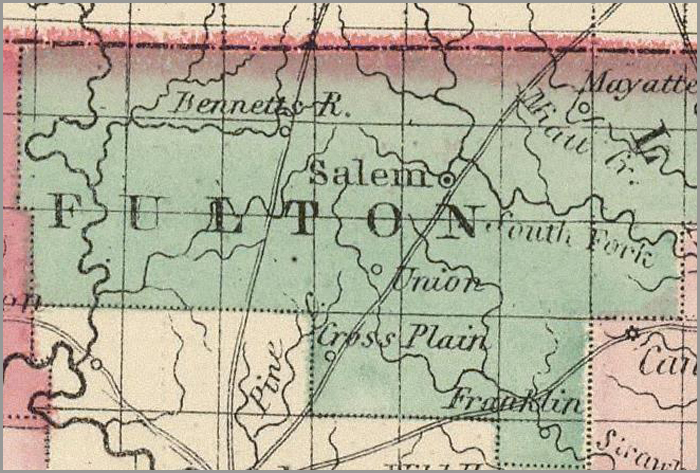Fulton County, Arkansas

Image courtesy of the David Rumsey Historical Map Collection
Fulton County, Arkansas was originally the territory of Native American groups but they were forced out by white settlers in the 1830s. Many early settlers, like William P. Morris, were veterans of the War of 1812 who had received land grants for their service. The county was officially formed on December 21, 1842, and named after William S. Fulton, a governor of the Arkansas Territory. Salem was named the county seat. The population grew steadily in the years leading up to the Civil War, 1,819 people in 1850 to 4,024 people in 1860. The county is located on Mammoth Springs and the Spring River, yet the soil was of poor quality for agriculture. The county did offer settlers ample pastureland for raising livestock.
When the Civil War began, most residents sympathized with the Confederacy, though there was a natural division between the settlers. Residents near the rivers tended to own slaves, while residents further upland from the rivers did not own slaves. In the 1860 Census, it was recorded that there was 88 slaves in Fulton County. Fulton County men formed a Home Guard unit on May 27, 1861. There was not much direct troop action, except on March 13, 1862, when the Battle of Salem (sometimes called the Action at Spring River) took place. Federal Lieutenant Colonel Samuel M. Wood, led the 6th Missouri Cavalry and the 3rd Iowa Cavalry into Arkansas with the goal of breaking up several scattered Confederate regiments seeking to combine their strength. These Confederate regiments, led by Colonel W.O. Coleman, Colonel J. Posey Woodside, and Colonel Archibald McFarlane, were defeated in the battle and were not successful in their attempt to unite. Federal troops moved back into Missouri, and there was no further troop action in the county. However, guerrilla warfare was prominent and residents suffered at the hands of the Bushwhackers.
After the war, recovery was slow but was aided by railroad construction at Mammoth Springs. Residents also began raising pigs and cattle and growing corn and cotton for profit rather than subsistence. The population continued to grow, 4,843 people in 1870 to 6,720 people in 1880.
 Browse all collections in Fulton County
Browse all collections in Fulton County
- Consulted:
- http://www.encyclopediaofarkansas.net/encyclopedia/entry-detail.aspx?search=1&entryID=769.
- Fulton County, AR, 1860 U.S. Federal Census – Slave Schedules [database on-line]. Provo, UT, USA: Ancestry.com Operations Inc, 2004. Original data: United States of America, Bureau of the Census. Eighth Census of the United States, 1860. Washington, D.C.: National Archives and Records Administration, 1860. M653, 1,438 rolls.












